This year marks The Legend of Zelda’s 25th year in the video game industry, a fact that Nintendo made no bones about at E3 this year, putting on a stunning symphonic display to honor its quarter-of-a-century anniversary. While we’re getting a double-dose of Zelda this year thanks to the releases of Ocarina of Time 3DS recently and Skyward Sword some time this holiday season, let’s take a look back through those 25 years at the best–and the worst–the series had to offer.
First, to set the tone for the rest of this article, the Legend of Zelda Overture played at E3 this year.
youtube::w3VHcGif4jE::
Now go grab something to snack on–hell get a couple-dozen things to snack on–before you get into reading this, there’s 25 years of history to get through here.
Before we get into the games of the series, let’s look at two of the most memorable names behind the Legend of Zelda, and the role they played in bringing Link from being an idea to a fully realized protagonist in a compelling game series with memorable characters and music.
Shigeru Miyamoto, Father of the Zelda Series
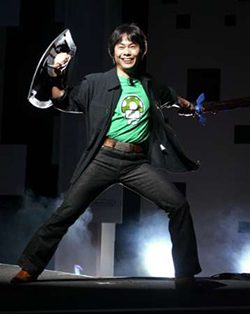
Currently a senior managing director at Nintendo and one of the most recognized names among both the gaming industry and gamers alike, Shigeru Miyamoto may be best known for his role in the founding of the Mario series, but he also had the founding role of the Zelda series as well in 1986. After producing Donkey Kong and Super Mario Bros. for the Nintendo Entertainment System, Miyamoto set out to create a new kind of gaming experience; for that experience, he went back to his childhood to find the inspiration. In an interview with GameSpot in 2000, he remarked he wanted to create a different kind of world “a miniature garden that [players] can put inside their drawer.” This idea came from his childhood in Kyoto, Japan where he would wander around the local area finding ponds, caves, forests and all sort of other places. From these memories spawned the land of Hyrule with its labyrinthine landscape, treacherous dungeons and the hero Link, a young man who was placed in extraordinary circumstances by chance.
Koji Kondo, Composer for the Zelda Series

Who can forget the original overworld theme or the epic battle music when squaring off against the demonic Ganon amid the ruins of his floating castle in Ocarina of Time? I could list many other examples, but I think each Zelda fan has their own favorite/memorable tune(s) that they can probably even hum right now (The Wind Waker’s ending theme anyone?). Coming up with the plot and the mechanics behind the game is a big job in and of itself, but without the music to bring the adventure to life a game is just a collection of pixels, polygons and other such technical things. It isn’t a far stretch to say a large part of The Legend of Zelda’s success over the years has been a result of Koji Kondo’s tireless work in writing memorable and beautifully crafted songs for the series, creating the memorable tunes we can hum today. Kondo’s work isn’t limited to the Zelda series, however, Kondo has been in some way involved with composing songs for other mainstay Nintendo series such as Star Fox and Mario.
The Legend of Zelda (1986)(NES)

The inaugural title for the Zelda series, The Legend of Zelda blazed a couple of trails for Nintendo in their first endeavor into the video game industry. It set us up with a minimal plot, a basic direction and the three critical characters to the Zelda plot: Link, Zelda and Ganon. The Legend of Zelda holds the distinction of being the first home console game to feature an internal battery for saving data and was also Nintendo’s first title to feature open-world exploration and non-linear progression, meaning the player could stop playing whenever you wanted to without worrying about starting over and the player wasn’t restricted to going from point a to point b (it was even possible to not pick up the sword and try to beat the game without it!).
The game’s overworld adventuring and dungeon-crawling gameplay along with its emphasis on collecting treasures in order to progress through dungeons and beating bosses created a unique gameplay experience for its time. Not to mention the puzzles in dungeons that involved clearing rooms and pushing random blocks in hopes of hearing that all-so satisfying jingle signaling a solved puzzle Throw in the option to farm up Rupees and shop, the extra hidden goodies and grottoes concealed behind obscure brush and walls and the clever-yet infuriating–overworld puzzles (like the graveyard, Death Mountain and the Lost Woods) and Nintendo suddenly found itself with a new series on its hands.
The Legend of Zelda earned rave reviews from critics, would go on to sell 6.5 million copies and became the first NES title to reach 1 million copies sold. Above all else, it taught us a very important lesson: That it’s dangerous to go alone, and if a strange old man offers you a wooden sword, you better damn well take it.
The Adventure of Link (1987)(NES)

Needless to say, The Adventure of Link–the second title in the Legend of Zelda series–had a tough act to follow. Link’s second journey on the NES would be a bit different then his first outing, however, courtesy of the game moving from a top-down perspective to using both a top-down perspective for overworld exploration and a side-scrolling perspective for village/dungeon exploration as well as running into enemy encounters on the overworld map. Because of the change in perspective–and the ability of Link to crouch–combat became more based on how Link was positioned in order to both defend and attack.
The story was long enough to provide plenty hour of gameplay. The original Zelda is revealed to be under a spell-induced coma, Link must set 6 crystals in palaces around Hyrule and go to get the Triforce of Courage to awaken Zelda; meanwhile Ganon’s followers want Link’s blood so they can sprinkle them over their dead master to resurrect him. Despite the design changes and story, The Adventure of Link scored lower than the original title and most of the future titles in the series (only the CD-i titles received a more critical reception, but Nintendo disowned those essentially, so they didn’t happen).
The CD-i Titles – Link: Faces of Evil; Zelda: The Wand of Gamelon; Zelda’s Adventure

Almost every long-standing series–whether the fans will admit it or not–has one (or many) title(s) that tanked so horribly that fans will vehemently deny that they ever happened so to avoid the inevitable embarrassment. Well, these titles are the case-in-point for Zelda. In fact, they were so bad that even Nintendo–the company as a whole–shuns the titles and only brings them up if absolutely necessary (they even failed to show them at their celebration at E3).
Despite that, allow me to clear up any possible lingering “Nintendo let this happen?” questions. Yes this atrocity occurred, I kid you not. Nintendo actually let this happen, I can’t make this stuff up. In fact, I put this paragraph here solely because I felt it absolutely necessary to assure you that it did happen.
*Ahem.* That aside, the games came about from Nintendo giving Philips the rights to five Nintendo characters (a disturbingly popular trend in the 90s for Nintendo) deciding against using the company’s CD add-on to the SNES. With the rights, Philips made three CD-i games featuring various characters from the Legend of Zelda universe. All of the games contained barely passable art, terrible design flaws, inconsistent control schemes, glitches, as well as corny stories, poorly-implemented mechanics and horrid voice acting and cut-scenes that earned the most scathing of reviews from critics everywhere. Then again, what should one expect with a $600,000 budget and a little over a year to complete the titles?
The Legend of Zelda: A Link to the Past (1991)(SNES)
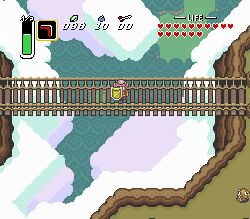
Returning to its top-down roots five years after the original Zelda title launched on the NES, A Link to the Past sought to erase the negative perceptions surrounding the series after the alright Adventure of Link and some other random games–which I can’t seem to recall–undoubtedly made some fans question the series’ future. A Link to the Past succeeded in restoring a good deal of that faith to the series, and in no uncertain terms.
A Link to the Past offered a lot of the classic Zelda allure while offering a new look and a new mechanic in the way of parallel dimensions and how the player interacts with them. The game also placed a new coat of paint over the classic Zelda experience, keeping it to par with the graphics and sounds of the time. The game consisted of the main storyline which could easily absorb upwards of 30+ hours of play on top of the various side quests and hidden items which could take up many more.
Even more varied were the amount of puzzles, bosses and treasures the game offered for the intrepid player to find. The shifting between The Light World and Dark World (Ganon’s twisted rendition of Hyrule) added to the game’s puzzle and exploration dynamics. In the end, A Link to the Past sold 4.61 million copies worldwide, becoming one of the 14 North American Players Choice titles (meaning it sold at least one million copies). Even 10 years after its release it was still regarded by fans to be possibly one of the best titles in the Zelda series (often contesting with Ocarina of Time for that distinction), placing high up on various Web sites’ “Top [insert number here] Games of All Time” lists.
The Legend of Zelda: Link’s Awakening (1993)(GB)

In 1993, gamers could take Link wherever they went (so long as the batteries lasted) when Link’s Awakening launched for the Game Boy. While sailing on the ocean, Link is shipwrecked on Koholint Island after a fierce storm. Using his trademark ingenuity, strength and weapons he must find a way off the island by waking the Wind Fish.
Link’s Awakening kept true to the classic Zelda formula, with the only exceptions being a few new items, an engaging and heart-breaking story and–for the first time in the series–a sequence of trading items to get a helpful item. The rest of the game is standard Zelda fare in a game world the same size as the original Hyrule in The Legend of Zelda featuring a few Mario cameos from a chain-chomp to a NPC with an eerily similar appearance to a portly plumber we all know. The game was well-received, scoring an average review score of 90 out of 100 (9 out of 10) with a few of the complains being the constantly needing to access the menu to change items and the monochrome color scheme. Nintendo would assuage the latter of those concerns in 1998 with a DX Version of the game with color graphics and bonus features.
The Legend of Zelda: Ocarina of Time (1998)(N64)
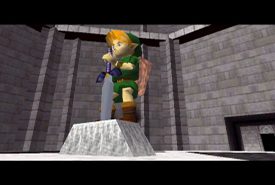
The Zelda series took another departure from the traditional top-down perspective to try its hand at the 3D gaming realm on the Nintendo64, only this time instead of being passable it was a landmark success. Link, a young Hylian, is tasked with stopping Ganondorf from stealing the Triforce from the Sacred Realm, except this time it’s going to take time-travel to see his task through to its end.
Ocarina of Time offered a whole goody-bag of new gameplay features as well as notable improvements upon old ones. First the new, players were now able to roam in a 3D Hyrule and introduced the Action Button (a button that does different things when in proximity to certain things). The introduction of a 3D environment offered the designers the ability to make new puzzles and more complex/frustrating dungeons (Water Temple anyone?). Aside from the other new items introduced in Ocarina of Time is the Ocarina (duh) which allows Link to play one of thirteen special tunes which serve a variety of functions from game progression to finding secrets. Real-Time Combat was treated very kindly by the venture into polygons and 3D, Link now had the ability to flank, evade, block and jump attack his foes using flashy jumps and tumbles. Among other new things included horse-riding along with mounted archery.
The engaging story made for a roughly 30 hour playthrough at a leisurely pace with a large bounty of sidequests and minigames to participate in which easily ate up 20-30 more. Ocarina of Time sold around seven million copies worldwide and received notably high reviews from a variety of media outlets (including a perfect score from the usually harsh Famitsu), scoring an average of a 98 out of 100 and was–and to an extent still is–considered the standard RPGs should be held to. The gameplay mechanics were strongly praised, especially the new control scheme and use of the 3D environment in level and puzzle design. One of the only blemishes, critics said, was the graphics and textures weren’t as sharp as some of the other titles that debuted the same year on the N64. Otherwise, critics called the game “perfection.”
The Legend of Zelda: Link’s Awakening DX (1998)(GBC)
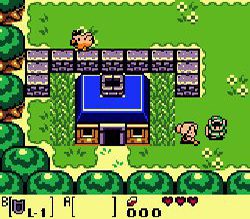
Hoping to improve on the criticisms for the original Link’s Awakening, Miyamoto and Nintendo sought to improve it by releasing a DX version that included color, slightly improved graphics and a few extra features to rope the new gamers in, including a new dungeon with a new item that significantly helped Link in his quest on Koholint Island. The DX version was received well, selling 2.2 million copies (on top of the 3.6 million sold by the classic) and was given unusually high marks for a remake.
The Legend of Zelda: Majora’s Mask (2000) (N64)

Two years following Ocarina of Time, Nintendo debuted Majora’s Mask for the Nintendo64. While not a direct sequel to Ocarina of Time, Majora’s Mask follows the same Link as he travels to the land of Termina in pursuit of a Skull Kid who stole a powerful mask and subsequently directed a scary-as-all-hell moon to crash straight into the planet in 3 days (seriously, the thing looks like its gone completely mental).
The game required a Memory Pak, so the game could be run at full graphical capabilities and such. Otherwise the gameplay remained mostly the same compared to Ocarina of Time, item usage and the Action Button remained the same as in Ocarina of Time. There was one notable difference, however: masks. In this game, Link may don masks which transform him into various things from the amphibious Zoras to a Deku Shrub and a Goron. Additionally, the time mechanic makes a return; Link is able to learn a tune that allows him to alter time so he may save Termina before the moon comes crashing down (how that doesn’t erase his progress when he steps back in time is beyond me, maybe he has The Doctor on his side).
Remarkably, while it took Ocarina of Time four years to be developed, Majora’s Mask was developed in one year with a smaller team thanks to the use of the game engine already in development and a bit of ingenuity from the development team to make unique challenges. While seemingly a rendition of Ocarina of Time, Majora’s Mask offered enough unique gameplay and mechanics to keep things fresh. The game sold 3 million copies worldwide and received great reviews (though nothing like its predecessor) which usually averaged around 90-95 out of 100. Critics gave high praise to the story told in Majora’s Mask (calling it deeper and more complex than Ocarina’s) and called the graphics more impressive courtesy of the Memory Pak.
The Legend of Zelda: The Oracle of Ages & The Oracle of Seasons (2001)(GBC)

The success of Link’s Awakening must have triggered something in the minds at Nintendo, for they brought Link to the handheld system in the Oracle series in 2001. The series continued the use of the shifting between certain states as a puzzle mechanic for progression and item-gathering (in Season’s case Link navigated through the four seasons and in Ages Link navigates once again through time) as well as offering new plots, items, dungeons and even a bonus quest if one game is played after the other using a password system or a link cable that offers bonus items and a story.
The ability to shift between seasons/time was the latest in the shifting mechanic in a Zelda game, but like before it was used in novel and non-stale ways to keep things fresh and fun. Another unique feature was the two games required players focus on different things to progress. While Ages focused more on puzzle-solving to progress, Seasons was fixed more on combat and action to see the day won. The linked quest was a first for the series and a novel idea for gaming as a whole. Not only provided great benefits like items and weapons, but also gave players a peek into what the true motives behind the actions Onox and Veran were.
Selling eight million copies combined and receiving an average review score of 92 out of 100, the Oracles series received praise heralding the two games as “the best games ever made on the Game Boy Color” from IGN and other reviewers. Critics complimented the gameplay, graphics and interlinking quest while giving criticism to the sounds, though admitting they were likely limited due to the GBC’s speakers.
The Legend of Zelda: A Link to the Past & Four Swords (2002)(GBA)

While A Link to the Past‘s return from the past was a nice surprise to anyone who loved A Link to the Past (which was pretty much everyone), the addition of a multiplayer element to the mix was certainly a nice touch. Like Link’s Awakening DX the port of A Link to the Past was hardly touched by Nintendo when brought to the Game Boy Advance, leaving the newest feature to be the multiplayer adventure which consisted of Link pulling thr Four Sword out of its pedestal and splitting into four copies to save Zelda from a new villain: Vaati.
In the multiplayer mode, two to four players traverse a couple of randomized dungeons, working cooperatively to clear the dungeon and competitively to collect the most Rupees. Progress made in these linked sessions are transferable to those who were involved in playing in the game (completing the multiplayer segment and learning new sword moves are a couple of things that transfer).
Critics gave the game generally high marks, praising its faithfulness to the original while adding enough unlockable features via multiplayer to keep the game fresh after a decade. A Link to the Past’s GBA port scored an average of 95 out of 100 and sold roughly 2.58 million copies worldwide, making it the best-selling Zelda title on the GBA.
The Legend of Zelda: Wind Waker (2002)(GCN)
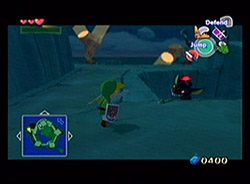
The first Zelda title some people were genuinely worried about since the CD-i games due to a major graphical departure from a more realistic style seen at a Spaceworld demo to the cel-shaded style seen at E3 2002. Despite the artistic change, however, Wind Waker offered depth, variety and a story to the Zelda series not seen since Ocarina of Time’s legendary outing four years prior. Wind Waker offered sailing as the major means of transportation through a mysteriously watery world dotted with islands in addition to new items and the use of wind as a means of navigating and puzzle-solving. With plenty of things to keep the player occupied during–and aside from–the main story, Wind Waker proved effective at keeping the die-hard Zelda “completionists” something to do for a long time. Items such as the Deku Leaf, the ability to wield your foe’s weapons and an emphasis on non-combat options to clear dungeons made both puzzle-solving and combat interesting. The story also offered considerably well-written dialogue and twists that linked in well with the Zelda mythology.
Despite the initial cringing and stuck-out-tongues, Wind Waker met with stellar success, becoming one of the GameCube’s most notable titles. Wind Waker sold 4.55 million copies, the fourth best-selling GameCube title behind Super Smash Bros. Melee, Mario Kart: Double Dash!! and Super Mario Sunshine. Wind Waker received Famitsu’s fifth perfect score in its 20 year history (at that point), won GameSpot’s Game of the Year Editor’s Choice Award and recieved an average review score of 96 out of 100.
The Legend of Zelda: Four Swords Adventures (2004)(GCN)

Taking a cue from the commercial and critical success of the Four Swords part of the A Link to the Past port, Nintendo developed a stand-alone game including the same concept and gameplay mechanics. Link must stop Vaati from wreaking havoc on Hyrule and stop a mysterious darkness from appearing (which is kidnapping the peasants of Hyrule and turning the Knights of Hyrule against Link) after the Fours Sword was pulled to stop an evil Dark Link. Gameplay works similar to the previous rendition with the Link to the Past port except this time the four Links can be controlled by the same player thanks to the addition of formations (diamond and line to name a few) the Links travel around in. The Links must get enough Force Gems in each location to gain access to the dark shadow in the region so they may fight the boss and move on, eventually gaining access to Vaati’s palace.
Graphics followed along the same fashion as A Link to the Past with a few stylistic additions (like the bomb explosions and such) seen in Wind Waker and some fancier touches like roaming cloud shadows for realistic touch. Four Swords also offered a multiplayer mode that required a Game Boy Advance and a link cable to make use of its “Shadow World” dimension (a secondary world where players can fight each other using the GBA. The four player medley of madness led to new hilarity and shenanigans when played with three other people, leading to some memorable gaming moments.
Four Swords Adventures didn’t have the best sales outing of the Zelda titles, selling only around 405,000 copies, but still managing to make the Player’s Choice list for GameCube titles. The title also picked up moderate review scores, earning around an average of 85 out of 100. Critics praised the frenetic gameplay, but criticized the visuals as they looked a bit low-key for a GameCube title. Another bit of criticism was that the multiplayer required a GBA and the link cable, which limited the options players had to play the game.
The Legend of Zelda: The Minish Cap (2004)(GBA)

Continuing the “proud” tradition of Princesses (and unfortunately very stereotypical), Zelda gets herself in trouble again – this time getting petrified by Vaati. Link is tasked by the King to seek out the microscopic Picori–or Minish–race in order to find a way to save Zelda and defeat Vaati once and for all. Minish Cap offers yet another new gameplay mechanic – the ability for Link to use the powers of the Minish Cap to shrink down to the size of the Minish in order to solve puzzles and interact with the Minish. Standard Zelda fare is abound in this title, Link travels from dungeon to dungeon, finding items that help him progress further and as before there is a strong emphasis on exploration. Minish Cap also introduced the ability for Link to roll like he did in the 3D titles and also to learn new sword techniques as the game progressed. The title also offered a figurine collection side-quest and a medallion collection side-quest (called Kinstone Collecting) that yielded rewards ranging from items to Heart Containers.
Critics gave Minish Cap–which sold 1.34 million copies–an average score of 92 out of 100, giving a variety of praises and criticisms. For one thing the visuals were both praised by some and admonished by others while the Kinstone system was considered ingenious by some and overly repetitive as all get out by others. The one common low mark was the length of the game being “too short” and the difficulty highly lacking. The common praise was the ability of Link to shrink and grow at will, making for some new puzzle opportunities.
The Legend of Zelda: Twilight Princess (2006)(GCN/Wii)

Link gets in touch with his beast side in Zelda’s first trip to the Wii. Twilight Princess represented a return to the art style that fans had expected to see after the Spaceworld 2002 demo. Link and Hyrule were portrayed in a very realistic and highly detailed graphical representation, lacking the brighter pallet of colors we saw in Ocarina and Majora’s Mask. Like Link to the Past, Twilight Princess offers a light and dark theme, but this time shadow is engulfing Hyrule and causing strange beasts to ravage passersby, not only that, but Hyrule Castle has been surrounded by a suspicious barrier, blocking access. In order to traverse the shadow and restore the light to all the provinces of Hyrule, Link must take the form of a wolf (yes, a wolf) and team up with a strange shadow being named Midna to both save Hyrule and his childhood friends (who were taken by the pesky Moblins).
Twilight Princess offered some new gameplay mechanics, including the highly anticipated mounted combat and more enhanced swordplay techniques, oh and did I mention he becomes a wolf? The ability to become a wolf allows Link the ability to dispatch the Shadow Beasts that inhabit the Twilight Realm (it’s not as angsty as it sounds and there are no fabulously sparkly vampires). New items, puzzles, an engaging story and new antagonist Zant and his plans make this title one of the more memorable and epic Zelda titles. The GameCube title and Wii title differed on how Hyrule was presented, the GameCube Hyrule was presented as Link was left-handed (which he is traditionally for those who didn’t know) and the Wii title reversed Hyrule (think of it like Hyrule’s reflection in a mirror) to accommodate the majority of Wii gamers being right-handed (so waggling the controller wouldn’t feel awkward).
Twilight Princess sold 5.89 million copies worldwide and received rave reviews from many notable publications (including some perfect scores), averaging a 96 out of 100. Critics all around praised the game’s long storyline and large variety of side-quests to keep things interesting. The size and scope of Hyrule and the ingenuity of the dungeons and items also received good marks. The only low points given to the game were on the Wii version, and that was the use of MIDI audio files for music, which “lacked the punch and crispness” of the GameCube’s music.
The Legend of Zelda: Phantom Hourglass (2007)(DS)

Just like Majora’s Mask was a sequel to Ocarina of Time, Phantom Hourglass was a direct sequel to Wind Waker. Following the ending of Wind Waker, Link and the pirate Tetra begin sailing in search of a realm that’s not all ocean and islands. While in search of this land they come across a Ghost Ship, and Tetra–being ever-fearless–jumps aboard. Link follows her when she isn’t heard from for a few minutes and next thing Link knows he wakes up on an island alongside a fairy with wings (Don’t worry, it’s not Navi, or Tatl for that matter) left to unravel the mystery of the local archipelago.
Phantom Hourglass made use of the DS touch screen to handle most of the interaction in the game. You can tap and hold the screen to see Link move around in the desired direction and tap enemies to attack them; players could also use the touch screen to navigate the Boomerang, having it do more than just go out and back. Link also used a steamship of one Captain Linebeck (and the touchscreen) to navigate the new archipelago, using the bottom screen to attack using a bomb canon and perform other navigation activities. Like Wind Waker, Phantom Hourglass provided a wide variety of mysterious islands both important to the plot and more puzzle-based that ensured hours of gameplay well beyond the stroyline. Also ensuring more hours was an online multiplayer mode over Nintendo’s WiFi Connection which put players in control of Phantoms (armored juggernauts from the storyline) in order to track down another player who controls Link and must navigate the maze.
Phantom Hourglass sold 4.82 million copies worldwide and received an average of 90 out of 100 from critics. Among the things critics praised Phantom Hourglass for were the graphics and control scheme using the touch screen as well as improving on some of the mechanics that Wind Waker used (such as island hopping and side-quests). The most obvious criticisms were the lack of challenge, some of the gimmicky mechanics (such as a timer) in the game’s signature dungeon–The Temple of the Sea King–and the lack of alternate control schemes led some critics to surmise that “Nintendo did not have The Legend of Zelda fans in mind then creating the game.”
The Legend of Zelda: Spirit Tracks (2009)(DS)
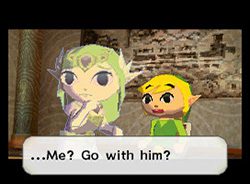
Zelda’s second title on the DS is a sequel to Phantom Hourglass, roughly a hundred of years later. In this iteration, Link has just been appointed the conductor for the royal family of the new-ish kingdom of Hyrule (they have trains now, by the way, thought you should know that) when Zelda is placed in danger yet again. Only this time the evildoer won’t simply settle for kidnapping the princess and using her magic prowess for evil, oh no, this time Zelda is straight-out killed by the villain at the outset of the game (this one isn’t messing around). Zelda’s spirit lingers int the world and accompanies Link in his quest to figure out what is going on behind Zelda’s murder
Using a similar control scheme to Phantom Hourglass, Spirit Tracks offers a new mechanic in the form of both using trains to navigate the land and Zelda’s ghost to help Link in his adventure (instead of shouting look out and listen). In her spirit form, Zelda gains the ability to possess the Phantoms from Hourglass to help in dungeon navigation/combat. Using the overworld mode and train travel, Link can navigate similarly to how the ship in Phantom Hourglass worked: having a canon for combat and using the stylus to draw the route. Taking a cue from critical jabs at Hourglass, Spirit Tracks does offer a central dungeon, but does not use a life-draining curse or a time limit as an obstacle.
Spirit Tracks sold 2.84 million copies worldwide, nearly half of what its predecessor sold. Critics received the game very well, Spirit Tracks receiving an average score of 87 out of 100 receiving generally positive reviews praising the use of Spirit Zelda and Phantom control as well as the dungeon design, difficulty, boss challenges and a good story with funny dialogue. The primary criticisms came from the train system, which most reviewers felt was restricting despite being an innovative idea. Other comments included how the game didn’t seem to include anything really new to the series and how designing the game around the train system may not have been the best thing to center a game around.
The Legend of Zelda: Ocarina of Time 3DS (2011)(3DS)
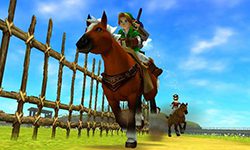
Which brings us to the here and now, and the triumphant and fanfare-filled return of what many deem to be the series’ pinnacle of perfection: The Ocarina of Time. Launching a little over a decade after its predecessor, Ocarina of Time 3DS brings new features to the table while claiming to keep the core gameplay the same. The story remains as epic as it was 13 years earlier: Link and Zelda seek to stop Ganondorf from engaging in his evil schemes concerning the Triforce.
Ocarina of Time 3DS offers a variety of new features to keep the old fans satisfied and the new ones entranced in the game. For one thing, the graphics were updated and enhanced to keep with the times as well as updated to make use of the 3DS’ stereoscopic 3D. The Master Quest (the tuned-up-in-difficulty mode) was also included to give players a new challenge alongside a Boss Battle mode in which players can re-fight bosses they have previously defeated. Additionally, the remake offers the ability to aim the Fairy Bow and the Boomerang (staple weapons in the Zelda series) either by analog stick or by tilting their 3DS to aim, making use of the gyroscopic feature built into the 3DS.
The highly-anticipated title has so far met success in the market, selling around 290,000 copies to date outside of the Americas and receiving extremely high praise from critics all around.
The Legend of Zelda: The Skyward Sword (2011)(Wii)
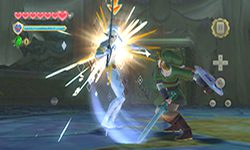
A title a long time in the making, The Skyward Sword for the Wii–and eventually the Wii-U–will introduce players to the history of the series’ landmark weapon: The Master Sword. Enter Link, who lives in a village in the clouds and Zelda (who Link seems to have a crush on). They go out flying on birds–which seems to a be a pastime of sorts–when disaster strikes and Zelda is seemingly swallowed by a mysterious and shadowy creature. Hoping to find her, Link takes to a monster-infested and highly dangerous surface dressed in the traditional green tunic with sword and shield at-hand. Also on the surface is a strange pale-skinned man named Ghirahim (seen above) who appears to serve as Link’s nemesis in this title.
Skyward Sword will introduce something Zelda fans have longed for since the Wii’s debut: motion-controlled swordplay that is both accurate and smooth. Using the WiiMotion Plus, Zelda fans may get to finally experience that kind of 1:1 sword-fighting control scheme. It’s a good thing too, because in Skyward Sword, Link will have to make specific attacks to take advantage of an enemy’s weakness in their defenses (such as horizontal or vertical slashes or even stabs). Link will also travel to locations on the surface using a bird and descend from there.
It will be interesting to see what the future holds for this particular entry in the Zelda series, considering the hype it has received and the anticipation that is building up.
Here’s to another 25 Years
As the 25 year mark comes and goes, it’s remarkable to see a series has maintained that much staying power in an industry, how much it has evolved and how many fans/memories it has created. One must wonder if Shigeru Miyamoto could have anticipated the epic saga that one vision in the late 80s was going to become over the next 25 years. Not only have the various Zelda titles enchanted players with its storyline over the years, they have also tread new ground in gameplay innovation with interesting new gameplay mechanics and use of technology to bring their labor to completion. While not every title has been as smashing a hit as the Ocarina of Time was in 1998, each title–except for the CD-i titles–contribute to the epic that is the Legend of Zelda along with all of the stories and memories we all have crawling through dungeons, felling the hordes of darkness, hearing that satisfying jingle when a puzzle is solved or a treasure chest is opened and the wonder of trekking through whatever realm we wind up in and saving the day.
With all of that mind, here’s to another 25 memorable years of Link screaming inaudible words and memorable dungeon-crawling experiences. What are your favorite moments and memories from The Legend of Zelda?




